

My Crazy Moroccan Food Safari
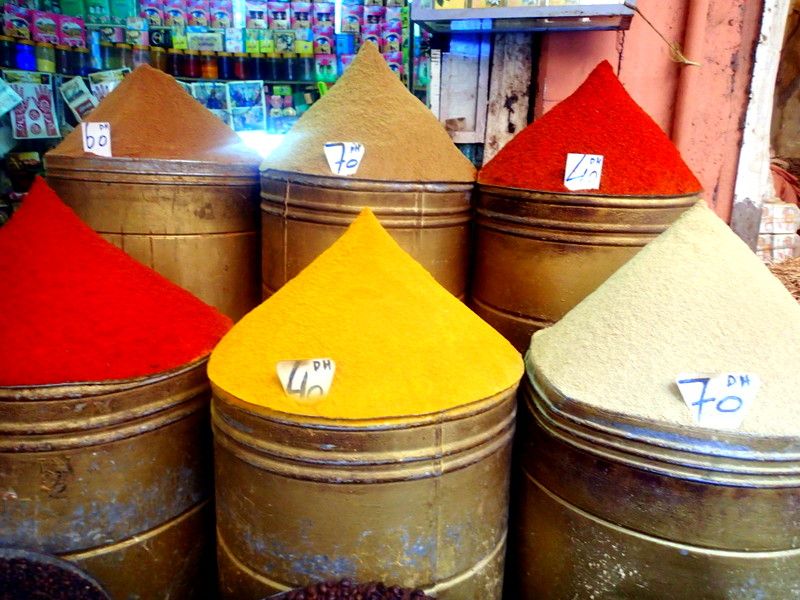
I wander through the medina’s chaotic streets, my stomach growling with hunger. Vendors constantly surround me trying to get me to buy rugs, argan oil, and vibrant spices. Old women clutch my clothing asking for money. One man even chases me around the square, trying to shove a snake in my face. I stop for none of it. I take no pictures.
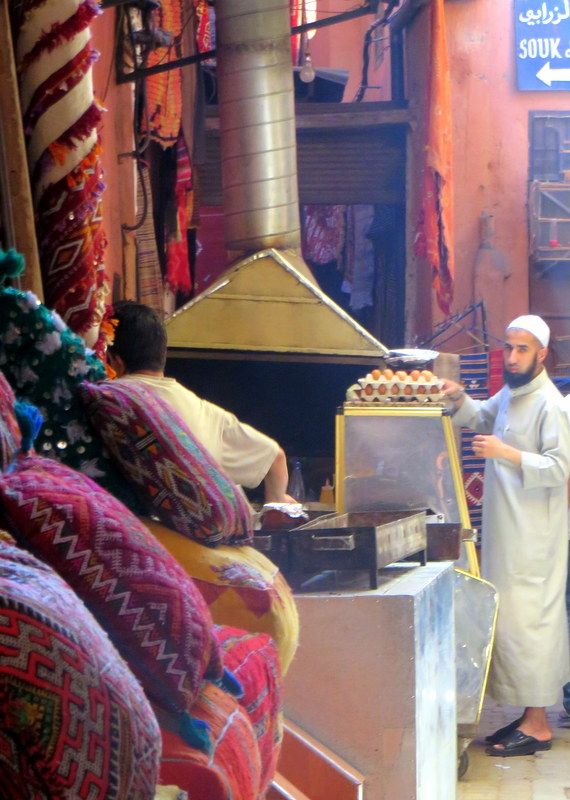
Then, I turn the corner, and I am surrounded by dozens of lamb’s heads sitting on top of tagines. I know this has to be the place. A man at the counter tears lamb apart with his bare hands. I warily look around, as my stomach grumbles louder. There are no other tourists. This is a good sign. “One please.” I say, boldly stepping up to the counter.
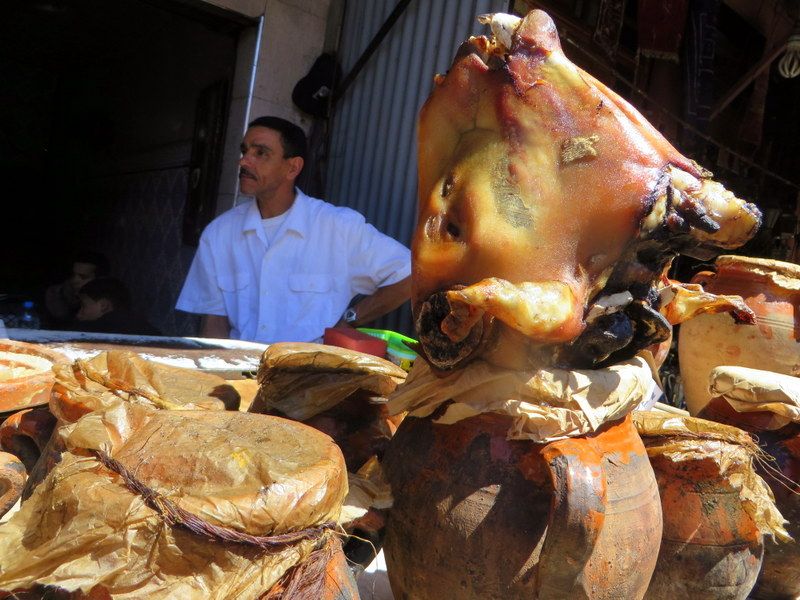
I am taken to another counter where another man tears even more lamb apart, and he asks me how much I want. I settle for 250 grams (even though I could eat twice that amount), and the man weighs the meat, heaps a piece of bread on top, and there is lunch. I have no silverware, no napkins (a piece of paper-the typical “napkin” in Morocco is brought at the end of my meal for me to use as a napkin), and so I sprinkle the cumin-salt mixture on top and dig in. Grease from the tender lamb drips down my chin as I grin the grin of a hungry woman finally getting fed. The sweet mint tea that is brought is the perfect accompaniment. I eat every mouth-watering bite, and can’t believe how delicious it is. I give all the men watching me a thumbs up, as I listen to the tunes coming in on the old radio. They give me a thumbs up back and proceed to give me a tour of the oven.
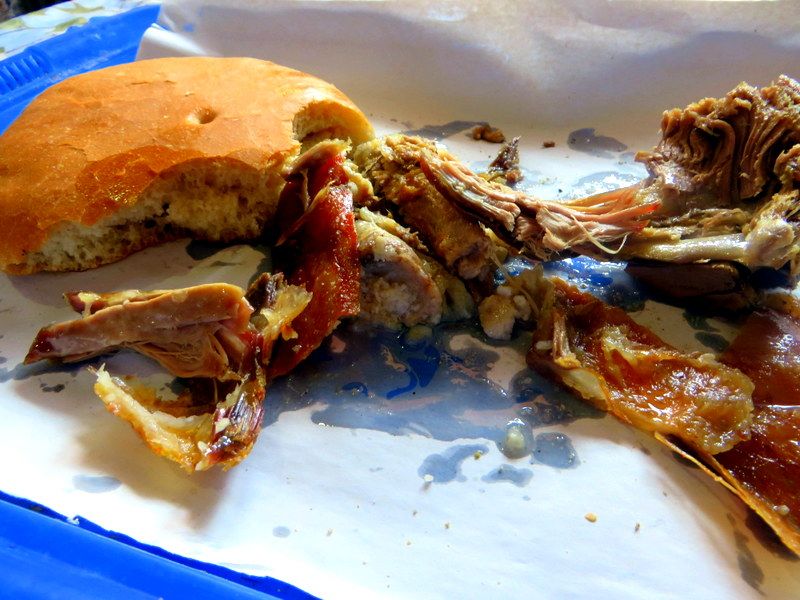
Several nights later, I pass by here again as a part of the Experience Marrakech: Food and Market Tour of Djemaa El Fna Including Traditional Dinner (a tour that was sponsored by Viator). The men all remember me and greet me with smiles and pose again for pictures.
I am hoping on this tour, that I will get a taste of some street food, but I am surprised to learn from Mustapha, my guide, that street food is considered the lowest form of food that you can eat in Morocco. He tells me that food is supposed to be enjoyed communally in his culture. If a local is eating street food, it usually means he has been drinking ( a taboo in Muslim society) or that he has no family (another taboo). Also, many of the ingredients are inferior to the quality that is served at restaurants and the standard of hygiene is not good in Morocco, either. In fact, the locals look so far down on street food, that if you want to curse someone, you tell them, “Go eat street food.” That is the equivalent of telling them to, “Go to hell.”
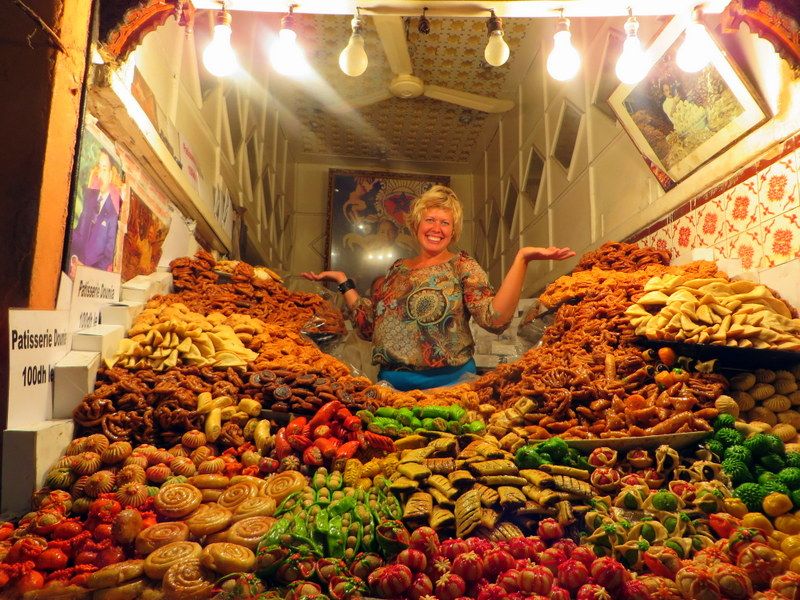
I am disappointed that we won’t be eating street food, as its sizzling smell are making me hungry, but I am given a great tour of the medina and a great history of Moroccan food. I learn that cooking is the most important thing for a Moroccan woman to learn, and her cooking skills determine her entire success in life. (Success meaning to them, whom they marry).
Shortly after getting married, the wife must prepare a special meal for the in-laws. They will present her with special cookies if they think she is a good cook. If they don’t present her with the cookies, it means that tough times are ahead, and she must spend many hours in the kitchen preparing to be a better cook.
I also learn that a man can determine his wife’s mood just through her cooking. I am shown the many spices that make up Moroccan cooking, and other essential staples such as olives, dried fruits, and nuts. The colors are vibrant,and the fragrance of the spices fills the entire medina with their smell.
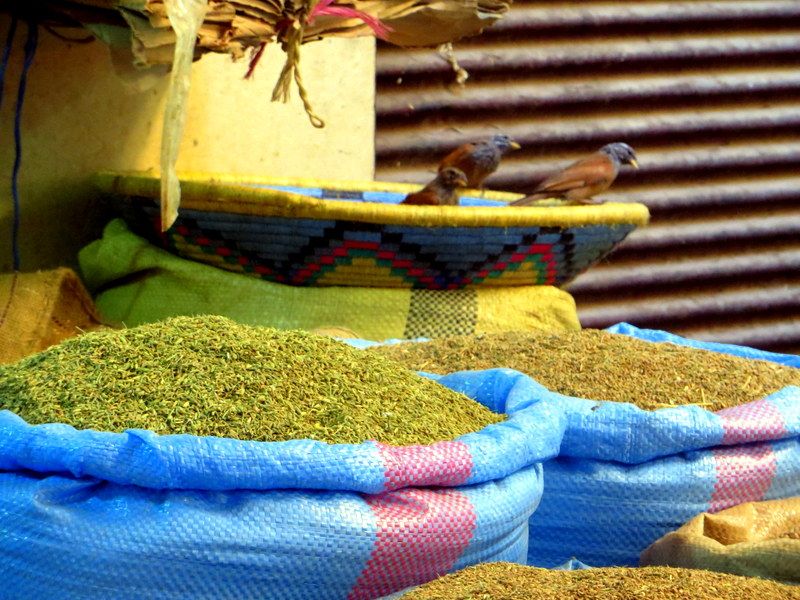
I also visit the local bread oven. The community brings their bread to a local bread oven, so they don’t have to heat their own homes with their ovens. They also like the smoky taste the community oven gives to their bread, as olive wood is used for the fires of the scalding hot oven. Of course, I am immediately put to work when I visit!
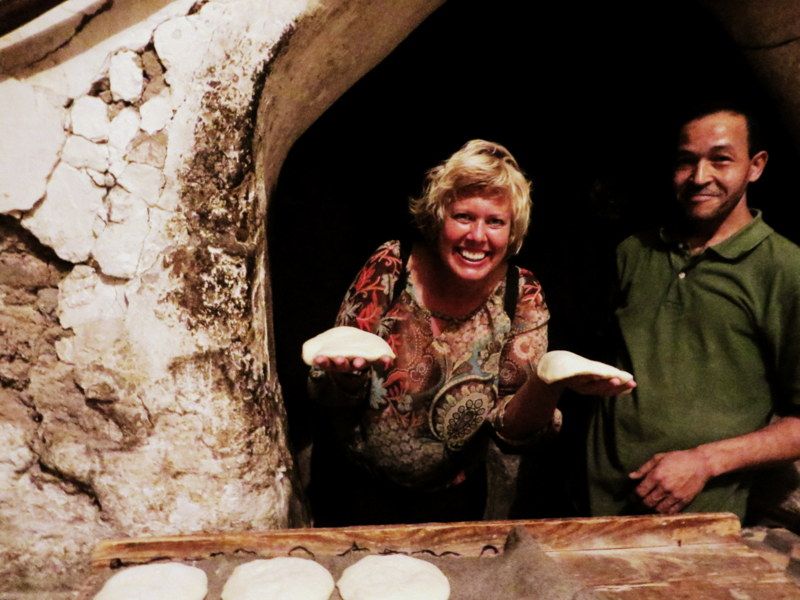
I also enjoy the traditional harira soup which is served during Ramadan as the first meal to break the fast. It is nurturing and flavorful.
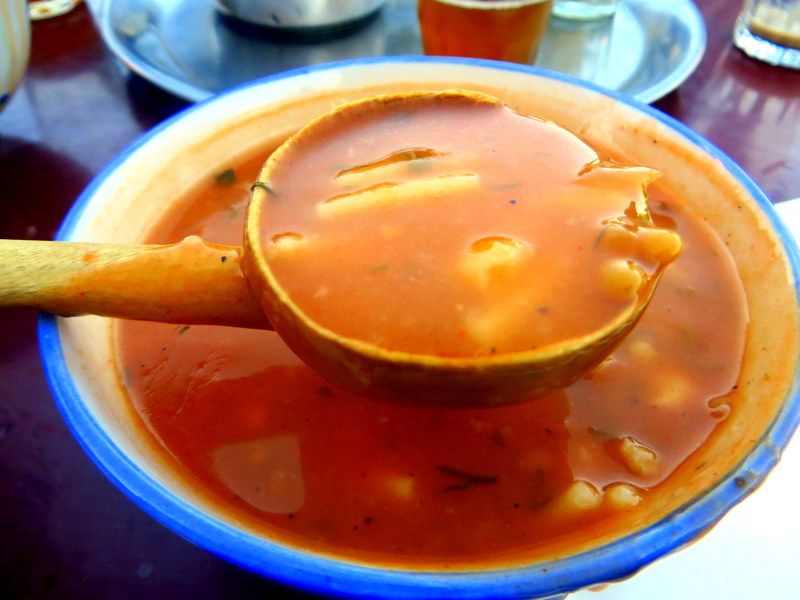
I eat piping hot Moroccan doughnuts served with Moroccan mint tea that is so sweet it makes my teeth hurt. I am the only woman at this local tea shop that is usually just frequented by men.

For dinner, I have a very special dish. I have beef that’s been slow-cooked in a clay pot for 12 hours with preserved lemons and olives. It is tender and moist. I think of all the work that the women go through just to prepare a meal. I pondered how their entire lives revolve around the food that will be served that day. While I love food and cooking, I can’t imagine living in a world where my success hinges on my ability to cook, and my entire social life revolves around preparing a meal. I said a prayer of gratitude for the freedom that I had.

I spend the rest of my time in Morocco, sampling the other tradional Moroccan foods. The tagines, the couscous, the chicken pastilla pie, with its layers of chicken, almonds, phyllo dough, and cinnamon and sugar.
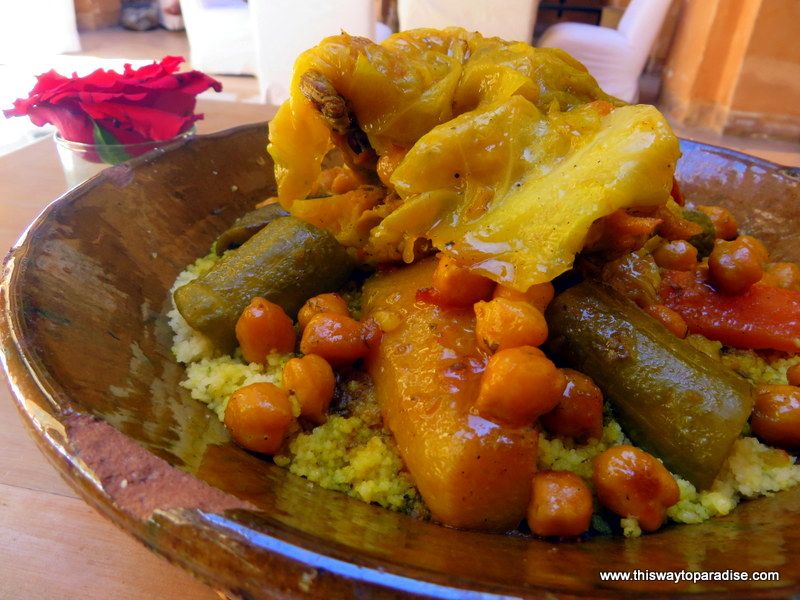
But, there is one thing that is still tempting me, one craving that I cannot deny. I cannot leave Morocco without tasting its illicit street food for myself. I feel like a kid again stealing cookies out of the cookie jar, as I order the kofta (minced beef) kebabs, as they still sizzle on the grill. I don’t care who feels sorry for me that I am eating alone, or who may think that the reason I am ordering them is because I have been drinking.
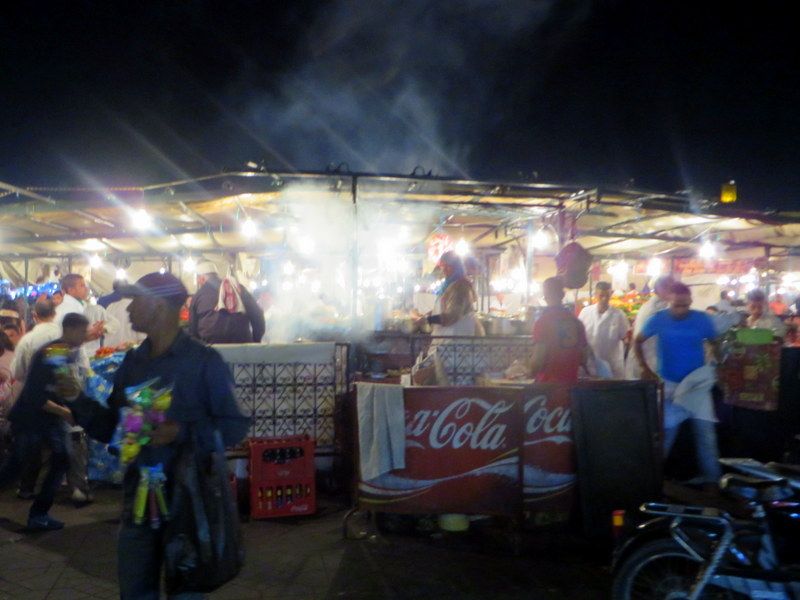
They are amazing. And, as I stuff the last harissa (spicy chile sauce) coated kofta in my mouth, I can’t help but wonder if street food will ever catch on in Morocco?
Somehow, I doubt it. Not with a culture so ingrained in the fact that it’s the woman’s job to cook every meal, and dinner time is a considered a sacred time where the family gathers around to talk and enjoy each other’s company.
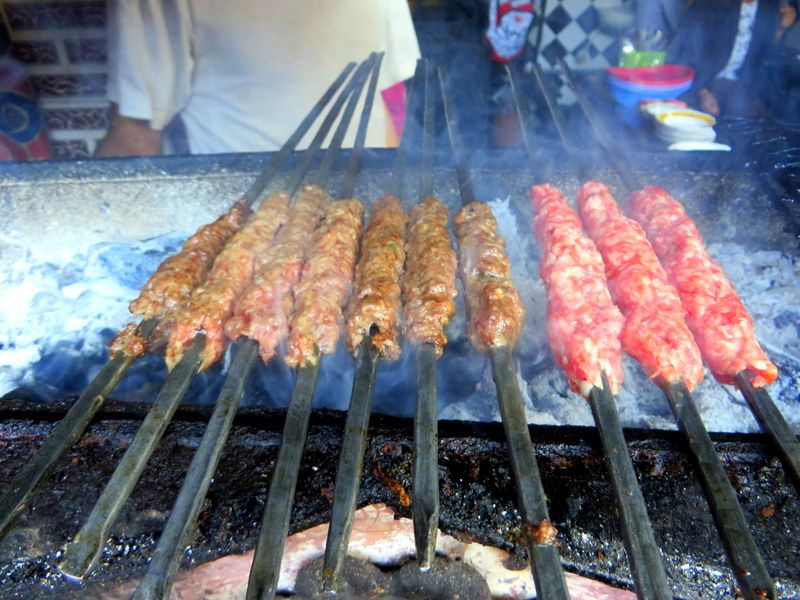
I end my food safari in Morocco, grateful for the tastes I have enjoyed, for the sights I have seen, but more grateful for my freedoms to travel freely, only cook when I want to, and to eat all the street food I can possibly devour.
Leave a Reply Cancel reply
Your email address will not be published. Required fields are marked *
This site uses Akismet to reduce spam. Learn how your comment data is processed .
© 2024 Eating The Globe-Food and Travel
Powered by Pinboard Theme by One Designs and WordPress
BIG discounts coming up in 2024! Get on the e-mail list for priority access & consideration.
A Taste Of Morocco. 8 Incredible foods to try on your visit to Morocco
Embark on a culinary journey through Morocco , where every bite tells a story of tradition and culture. A trip to this enchanting land is more than just a scenic escape—it's an opportunity to savour the soul of Moroccan cuisine.
From the bustling medinas to the tranquil oases, the flavours of tagines, couscous, and aromatic spices tell tales of history and hospitality. Don't miss the chance to indulge in these authentic dishes; for in Morocco, a true exploration is incomplete without enjoying the local food. Your taste buds are the gateway to great new experiences in this remarkable country.
Let's dive in and take a look at what food is at the heart of the Moroccan diet and discover the essential dishes you should be ready for. Your taste buds will thank you.
Moroccan Foods To Try
1. tagine treasures.
At the heart of Moroccan cooking is the tagine – a slow-cooked delicacy that's both an art form and a culinary masterpiece. Imagine succulent pieces of lamb, chicken, or any combination of vegetables gently simmered with fragrant spices like cumin, saffron, and ginger.
The tagine's cone-shaped lid ensures every drop of flavour is trapped, resulting in a tender, aromatic symphony that's a true delight for your senses.
2. Couscous Creations
Couscous, often referred to as Morocco's national dish, is more than just food; it's a symbol of togetherness. This fluffy semolina grain is meticulously steamed and then adorned with a colourful array of vegetables, tender meat, and aromatic spices.
As you savour each delicate bite, you're not just tasting a dish; you're sharing in a centuries-old tradition of communal feasting.
3. Spices And Flavors
Moroccan cuisine is a specialized game of spices, each one playing a vital role in creating its distinctive taste. Cumin adds warmth, saffron imparts a golden hue, and paprika infuses a hint of smokiness.
These spices aren't just ingredients; they're the threads that tie together the intricate tapestry of Moroccan flavours, balancing sweet and savoury in perfect harmony.
4. Street Food Adventures
As you wander through bustling Moroccan streets, you'll encounter a wide range of street food. From the hearty comfort of bissara, a fava bean soup, to the irresistible charm of msemen, a flaky pancake that's both crispy and soft, the vibrant street food scene is a window into the heart and soul of Moroccan culinary culture.
5. Fresh And Zesty Salads
Moroccan meals often kick off with a burst of freshness in the form of vibrant salads. Zaalouk, a smoky eggplant creation, and taktouka, a lively mix of peppers and tomatoes, are just a glimpse into the medley of flavours that await.
Drizzled with olive oil, adorned with fragrant herbs, and brightened with citrus, these salads are a refreshing prelude to the feast that follows.
6. Sweets And Treats
Diving into Moroccan sweets is like stepping into a world of artistry and indulgence. Pastilla, a delicate filo pastry layered with tender meat and almonds, is a savoury-sweet marvel that embodies Moroccan culinary creativity.
Chebakia, a sesame-coated treat, is both a delicacy and a testament to the craftsmanship that goes into creating these edible masterpieces.
7. Beverages And Elixirs
Morocco's culinary journey isn't complete without a sip of its signature mint tea, a refreshing elixir served with a flourish of tradition.
The fragrant aroma of mint mingles with the warmth of gunpowder green tea, creating a harmonious melody that perfectly complements the Moroccan climate. Spiced coffee, another local favourite, provides a robust and invigorating companion to your culinary exploration.
8. Regional Flavors
Morocco's diverse geography has given rise to a mosaic of regional flavours. In Marrakech , you'll encounter the fiery charm of dishes like tanjia, slow-cooked meat infused with smoky spices.
Fez offers a taste of pastilla that's steeped in history, while Casablanca boasts coastal treasures like grilled seafood that celebrate the bounty of the sea. Each region tells its own story through its cuisine, adding layers of depth to your gastronomic voyage.
Final Thoughts
While we haven't gone deeper with each dish and its various combinations, you now understand the wide variety of Moroccan food.
Deeply rooted in tradition, each dish is about much more than tasting food, it is a deep connection to the stories and culture that celebrated the flavours, traditions and shared human moments. So, as you savour each dish, remember that you're not just eating – you're experiencing the heart and soul of Morocco, one bite at a time.
From the captivating tagine to the communal joy of couscous, every bite tells a story of a land rich in history and hospitality.
A trip to Morocco is a connection to the past and the present. From old medinas, monumental mosques, beautiful villages and delicious foods, Morocco brings the past to the present in so many ways. This human connection leads to a sense of connectedness that is beyond descriptions.
Related Articles
- Morocco visa requirements for tourists
- Top places to visit in Morocco for holiday
Food Safari
Information
© 2007 Special Broadcasting Service Corporation
Copyright © 2024 Apple Inc. All Rights Reserved.
Internet Service Terms Apple TV & Privacy Cookie Policy Support
- Cast & crew

Food Safari
- Moroccan Safari - Maeve journeys into the world of Moroccan food and meets a range of top chefs and home-cooks who are passionate about their delicious cuisine.
- Food Safari journeys into the beguiling, gently spiced world of Moroccan food and meets a range of top chefs and home cooks who are passionate about their delicious cuisine. Food author and broadcaster Maeve O'Meara joins her friend restaurateur Omar Majdi who gives tips on the top spices and ingredients needed for Moroccan food.
It looks like we don't have any synopsis for this title yet. Be the first to contribute.
Contribute to this page

- See more gaps
- Learn more about contributing
More from this title
More to explore.

Recently viewed

Moroccan Food – 15 Traditional dishes to eat in Morocco
By: Author Swedish Nomad
Posted on Last updated: November 29, 2019
Categories Food , Morocco
Home / Africa / Morocco / Moroccan Food – 15 Traditional dishes to eat in Morocco

Want to know more about Moroccan food? Here are 15 traditional dishes to eat in Morocco as well as more information about the cuisine.
Moroccan food is well-known around the world for its rich flavors with spices and herbs as well as slow-cooked meats and delicious couscous. There are many interesting dishes that you should try when visiting Morocco, and here are some of my favorites!
The tagine is actually the cone-shaped cooking vessel which is usually made in ceramic or clay. It’s an integral part of Moroccan cuisine, and there is an endless amount of dishes that can be cooked in a tagine.
One of the most common tagines is with chicken and vegetables. If you haven’t had Moroccan food cooked and served in Tagine, you haven’t got the full experience yet!

Photo: Bernd Juergens/Shutterstock
Moroccan Sardines
Morocco is one of the largest exporters of sardines, and it’s also a popular food in Morocco. My favorite is the sardines that are stuffed with Chermoula. It’s mostly eaten in the coastal cities but sardines are also eaten and sold in markets in other parts of the country.
The stuffed sardines are usually served as a starter or side dish, and they are absolutely delicious.

Photo: picturepartners/Shutterstock
Brochettes are the Moroccan version of Kebab, and it’s one of the best street foods from Morocco which is available in markets all over the country. They are served on skewers and can be meat from chicken, lamb or beef which can be accompanied with bread and harissa.
The typical cost for a meal of brochettes is around 20 Moroccan Dirham , and it’s a great choice if you want a quick and delicious meal in Morocco.

Photo: Emimil/Shutterstock
Couscous is another typical food from Morocco which shouldn’t be missed. It’s recognized as the national dish of Morocco and is typically served with vegetables and some kind of meat.
Couscous is made from semolina wheat and it originated from the Maghreb cuisine. Since then it has become popular all over the Middle East due to its versatile use. It can be compared to bulgur or rice, but it has a distinct texture and flavor which is unique for couscous.

Photo: Moha El-Jaw/Shutterstock
Merguez sausage
Another local favorite from the Berber cuisine is the Merguez sausage, which is made from lamb. It’s popular all over the North African region, and Morocco is not an exception. It can be served with bread or in a tagine.

Photo: hjochen/Shutterstock
Fish Chermoula
Chermoula is actually a thick marinade that is specifically prepared for fish and seafood. It’s mix of spices and herbs and can come in different variants, and there are several dishes in Morocco which use chermoula for fish.

Photo: Elzbieta Sekowska/Shutterstock
Harira is a flavorful lentil and chickpeas soup that is commonly eaten during Ramadan to break the fast, but it can also be served at home or in restaurants as a starter.
It’s an easy-to-make soup where the stock is often made with beef or lamb, and chaariya (noodles) are added to make it savior.

Bread is a big part of Moroccan cuisine, and there are many varieties. Khobz is one of the most popular breads in Morocco, and it’s baked in wood-fired ovens and commonly served on the side to various meals.

Photo: vasara/Shutterstock
Moroccan Chicken Bastilla
This is a chicken pie that is traditionally served on special events, but it can also be made at home and it’s available in some restaurants too.

Photo: Largo Nadin/Shutterstock
Tanjia is most common in Marrakesh, and just like the tagine, it’s a clay pot dish that is usually made with beef, lamb or chicken. Tanjia dishes are known for their rich flavors with plenty of herbs and spices.

Photo: Evgeni Zotov/Flickr
Kefta is Moroccan meatballs and can be served with couscous, vegetables, and various spices. The meatballs are made of ground beef or lamb which is mixed with paprika, onion, coriander, cumin, and parsley. Some recipes include cinnamon, mint leaves, and cayenne pepper.

Photo: ilolab/Shutterstock
Rfissa is another traditional dish from Morocco, which is mainly served during celebrations. It’s usually made with chicken and lentils as well as fenugreek seeds, msemmen, and ras el hanout. It’s often decorated with quail eggs, fruits and nuts to add to the festivity.

Zaalouk is a type of cooked salad which is made with eggplant and tomatoes. It also includes garlic, spices, and olive oil. Zaalouk is typically eaten with bread and served as a side dish.

Photo: Mariontxa/Shutterstock
Lamb or Beef with Prunes
This combination is another showcase of the excellent and unique flavors of Moroccan cuisine. This dish can be made with either lamb or beef, which is cooked together with spices until it’s really tender. Prunes are added on the top along with almonds, and some syrup.

Photo: Cristina Stoian/Shutterstock
More about the food from Morocco
As a foreigner, you’ll find the Moroccan cuisine to be both colorful and flavorful. It’s not too spicy, but the dishes all have rich flavors due to the heavy usage of spices and herbs.
Beef, lamb, and chicken are the most common meats and a typical meal will always include some kind of meat as well as salad, couscous, bread, and vegetables. Tagine is the typical way of cooking dishes, and in general, you’ll find Moroccan food to be very healthy.
The main influences of the Moroccan cuisine can be traced back to Berber, Maghreb, Jewish, and Arab cultures. It’s very unique with flavors that you won’t find elsewhere in the world.
The best Moroccan food is usually found in the souks and local restaurants where the locals are eating. Avoid the touristy restaurants and ask the locals for advice on good places to find authentic food from Morocco.

Photo: Peter Wollinga/Shutterstock
What is typical Moroccan food?
A typical meal in Morocco is made with chicken, beef or lamb in a tagine with vegetables. Couscous is also very typical Moroccan food.
Is Moroccan food spicy?
Authentic Moroccan cuisine uses a lot of spices, but it’s not necessarily spicy per se, although it will be very flavorful. Most Moroccan food isn’t spicy hot.

What do they eat for breakfast in Morocco?
Bread, olives, goat cheese, eggs, pancakes, jams, and tea are all common in a typical Moroccan breakfast.

Moroccan Food etiquette
Which hand do moroccans eat with.
Moroccans always eat with their right hand and will almost never use their left hand in conjunction with eating.
It’s customary to eat with your first two fingers and the thumb. Only use your left hand to pick bread or passing dishes to others.
Can I drink alcohol in Morocco?
While alcohol is forbidden in Islam , there is still alcohol available in Morocco. Alcohol can only be consumed and purchased in licensed hotels, bars, and tourist areas.
Additionally, there are supermarkets selling alcohol, but only foreigners are allowed to drink alcohol in public. Some Moroccans who aren’t religious might drink alcohol from time to time, but it’s not something that is customary.
Don’t refuse food in Morocco when offered
If you’re invited for dinner or being offered some food for free in Morocco, it’s considered rude to turn it down and say no. Always accept the offer if you want to be polite and follow Moroccan food customs.

Photo: IssamDesign/Shutterstock
Which is your favorite food from Morocco? Leave a comment below!
Danial (Dan On The Road)
Sunday 22nd of March 2020
Tanji looks really enticing and I bet it would be as flavorful, if not more, as a pot of Tagine!

Mhancha popcorn

Moroccan amlou
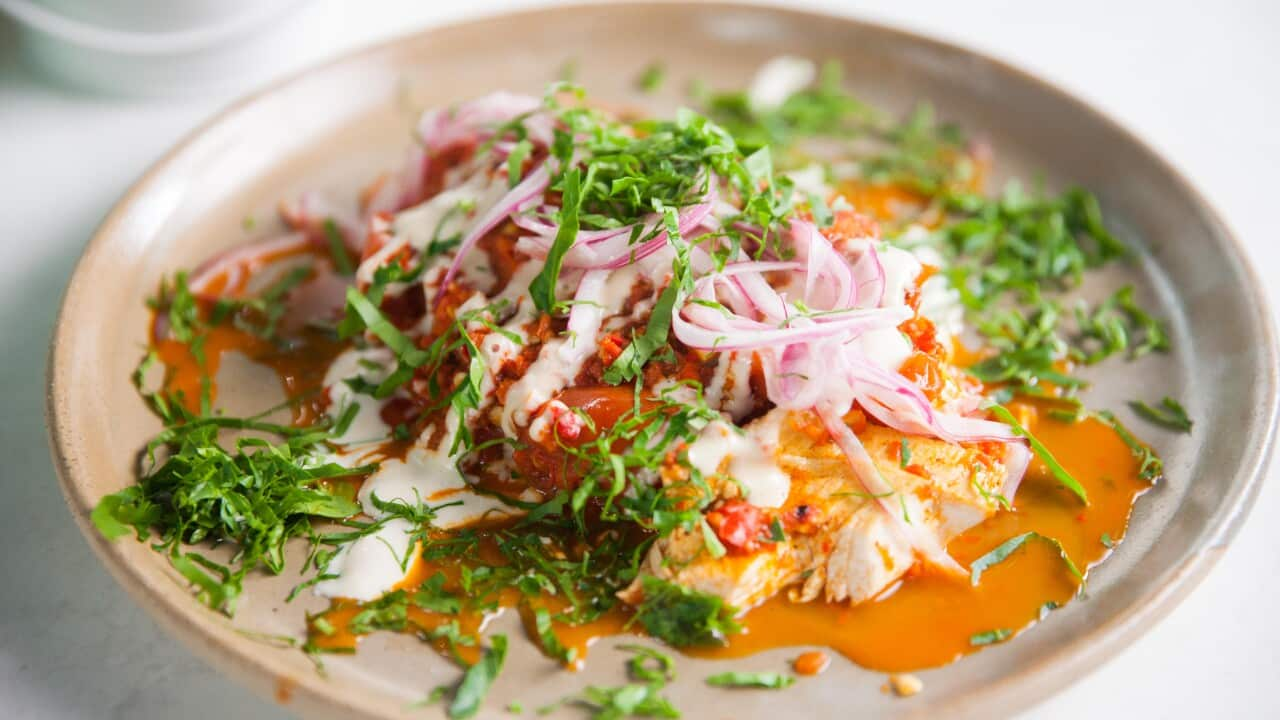
Chraime (spicy Moroccan fish)
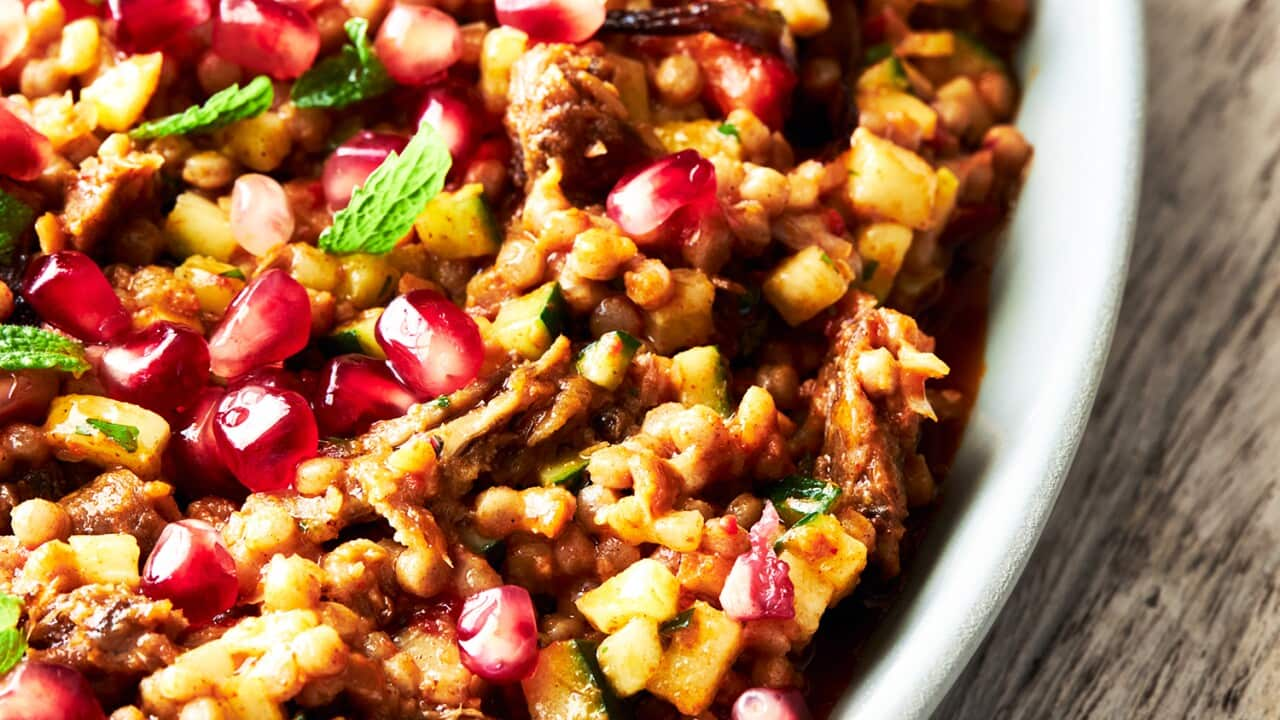
Heston's Moroccan vegan couscous with spiced romesco

Mini chicken pastillas

One-pot rose harissa chicken and apricot pilaf
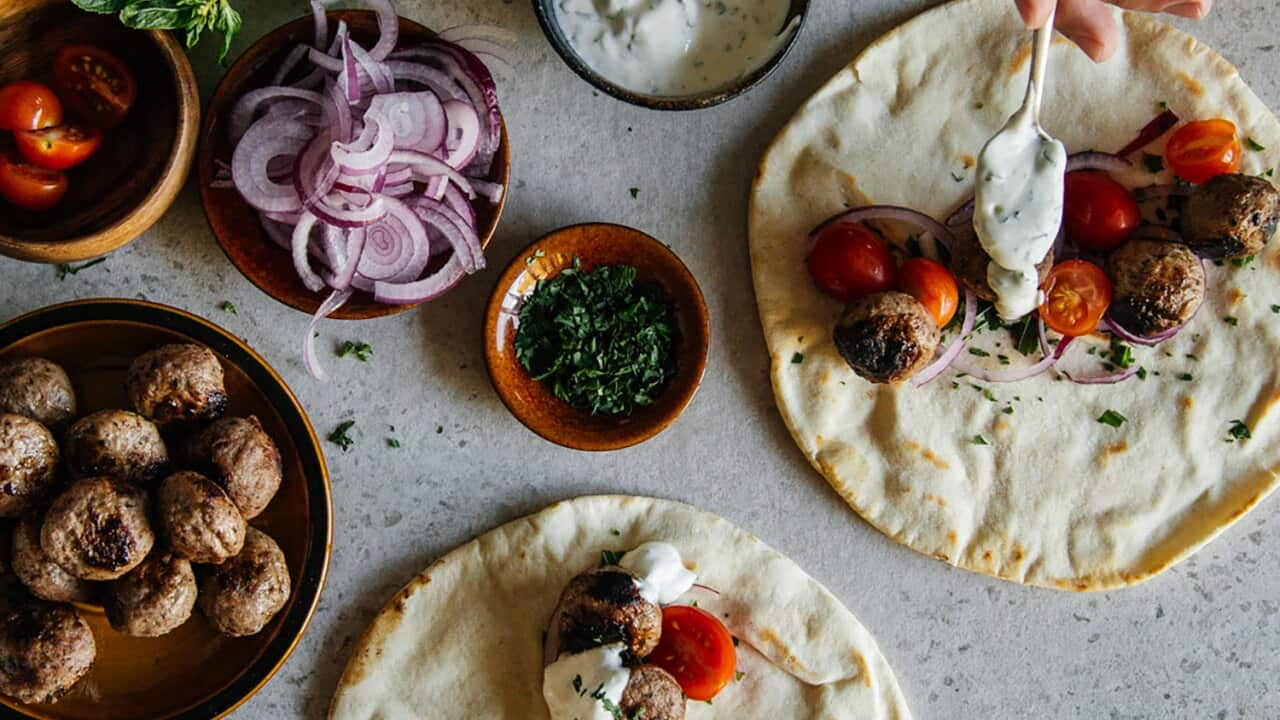
Moroccan lamb meatballs with minted yoghurt

Moroccan chickpea pockets

Flaky chicken and almond pie

Vegetable tagine
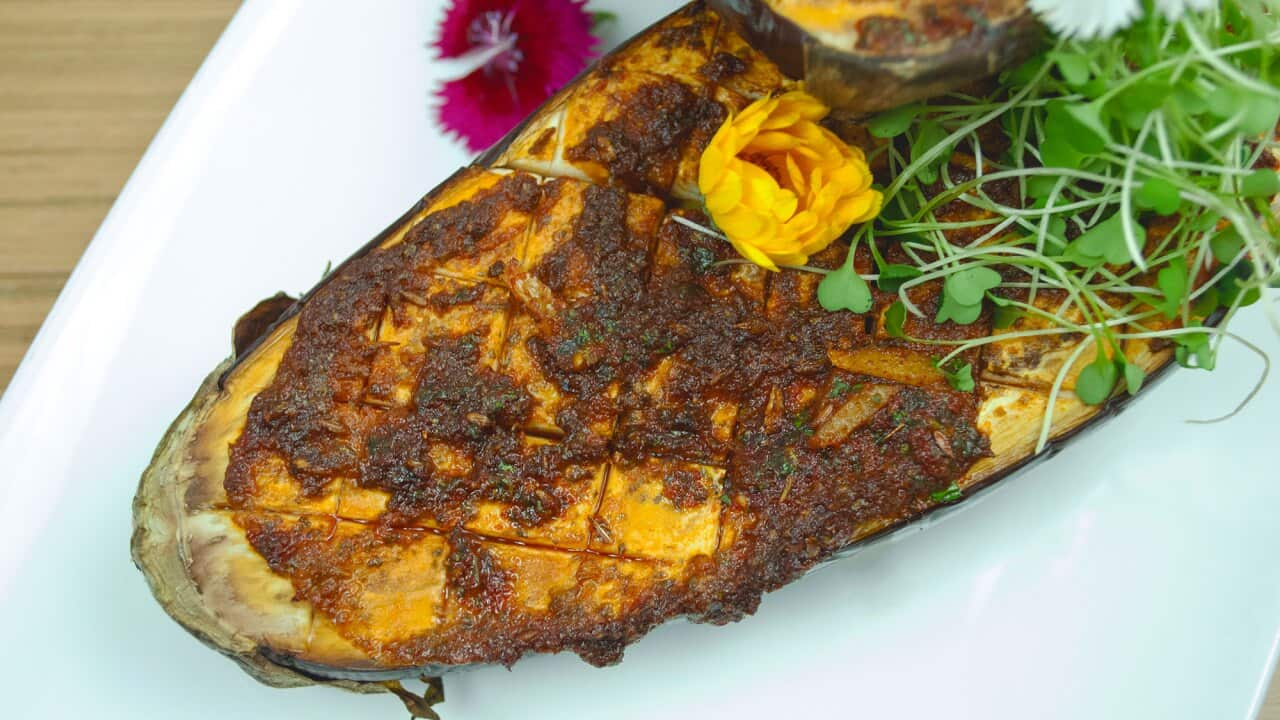
Chermoula eggplant
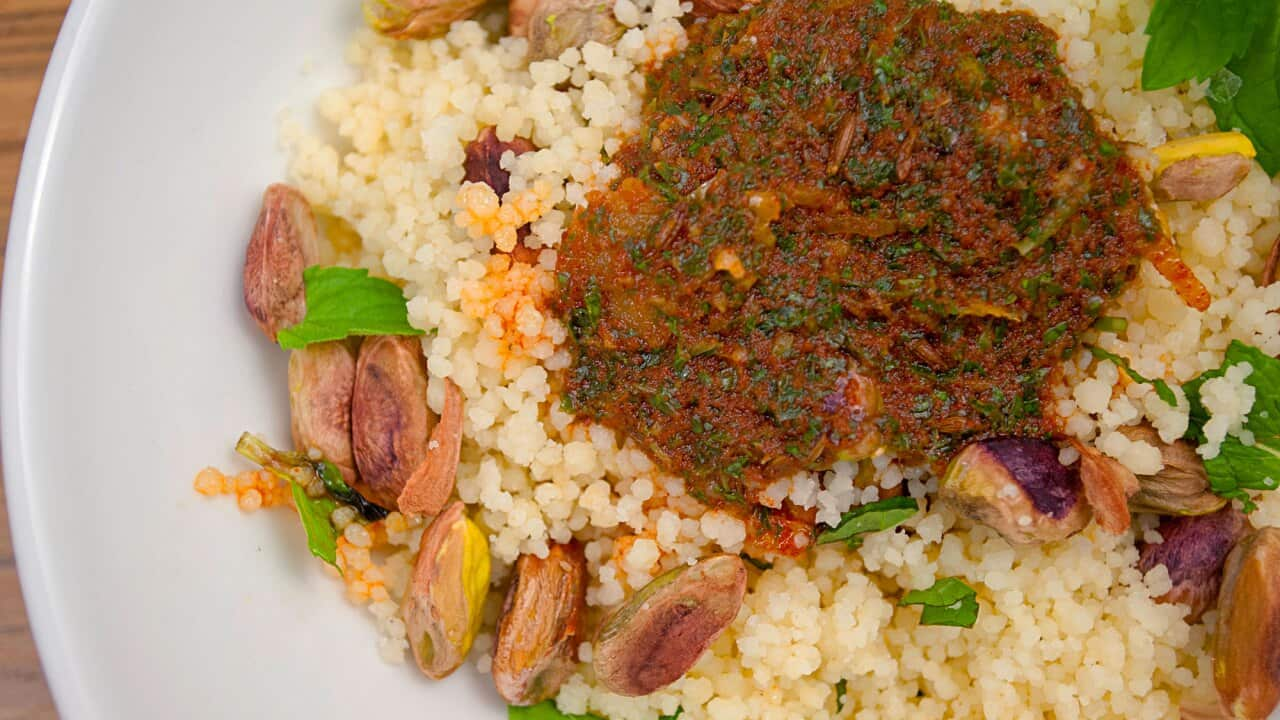
Chermoula couscous
Sbs food newsletter, get your weekly serving. what to cook, the latest food news, exclusive giveaways - straight to your inbox..
By subscribing, you agree to SBS’s terms of service and privacy policy including receiving email updates from SBS.
Bring the world to your kitchen
- Itineraries
- Where to go
- Accommodations
Luxury & Private Safaris in Morocco
Morocco is a country of many facets, reflecting its rich cultural heritage and long and colorful history. This predominantly Muslim country is renowned for delicious cuisine, beautiful architecture, exotic souks and a flourishing Berber culture. Geographically, Morocco is characterized by rugged mountains, fertile oases, ancient fortified port cities, and magnificent deserts. It is one of only three countries with both Atlantic and Mediterranean coastlines and has long been a favorite destination for travelers.
Many flights arrive into Casablanca, which is home to the famous Hassan II Mosque and Rick’s Cafe (of movie fame), and serves well for a logistical overnight. Marrakech and Fez are much older cities and they, along with Rabat (the capital and home to several important historical sites), and Meknes are Morocco’s Imperial Cities. Upon entering Fez’s medina (old city), with its dark winding alleyways and ancient sounds and smells, one is transported back in time to its founding in the 9th century. In contrast, Marrakech’s bustling souks (markets) – where one can buy handwoven textiles, daily household goods, along with exotic spices – are very much operating in the moment for locals and visitors, though replete with historical influences. Luxury hotels with elegant courtyards, luxurious linens and modern hammams (bath houses) pamper the most discerning clientele. Traditional and fusion Moroccan cuisine have made restaurants in Morocco destinations for serious foodies. Similarly, for shoppers interested in art, textiles and unique housewares, the choices are endless from refined high-end specialty shops, to prowling open air markets. Top cultural sites include the tomb of Fez’s founder Moulay Idriss II, the medinas of Fez and Marrakech, Skoura’s iconic Kasbah Amridil, and the “blue city” of Chefchaouen . Further afield, the Atlas Mountains and the vast dunes of the Moroccan Sahara beckon those looking for “off the beaten path” experiences, perhaps astride a camel, or in the lush gardens of a beautiful fully inclusive destination hotel such as Dar Ahlam … travelers to Morocco really can “have it all”!
Secrets and Tips from our Experts
- A great local guide is invaluable, and essential in Fez
- Don’t miss the photography museum (Maison de la Photographie de Marrakech) and the Majorelle Garden
- Take a day trip to Meknès
- For a smaller city experience check out Essaouira on the coast (also a film site for Game of Thrones )
- Classic, riad-style hotels with an inner courtyard can be noisy if your room does not have air-conditioning – good to double-check.

Learn more about Morocco’s rich culture in Casablanca
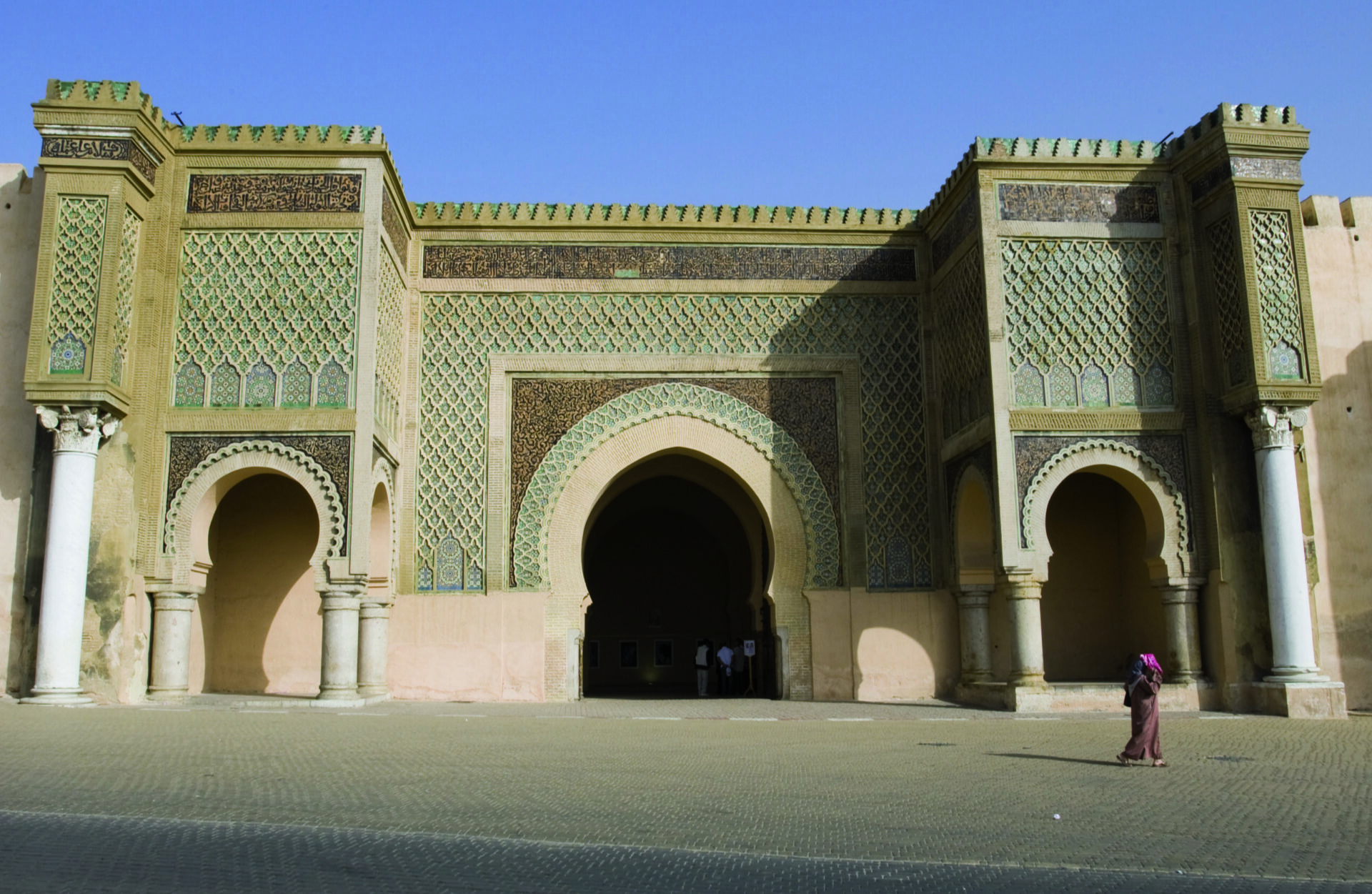
Ride by camel across the desert dunes at Merzouga

Disconnect from the world
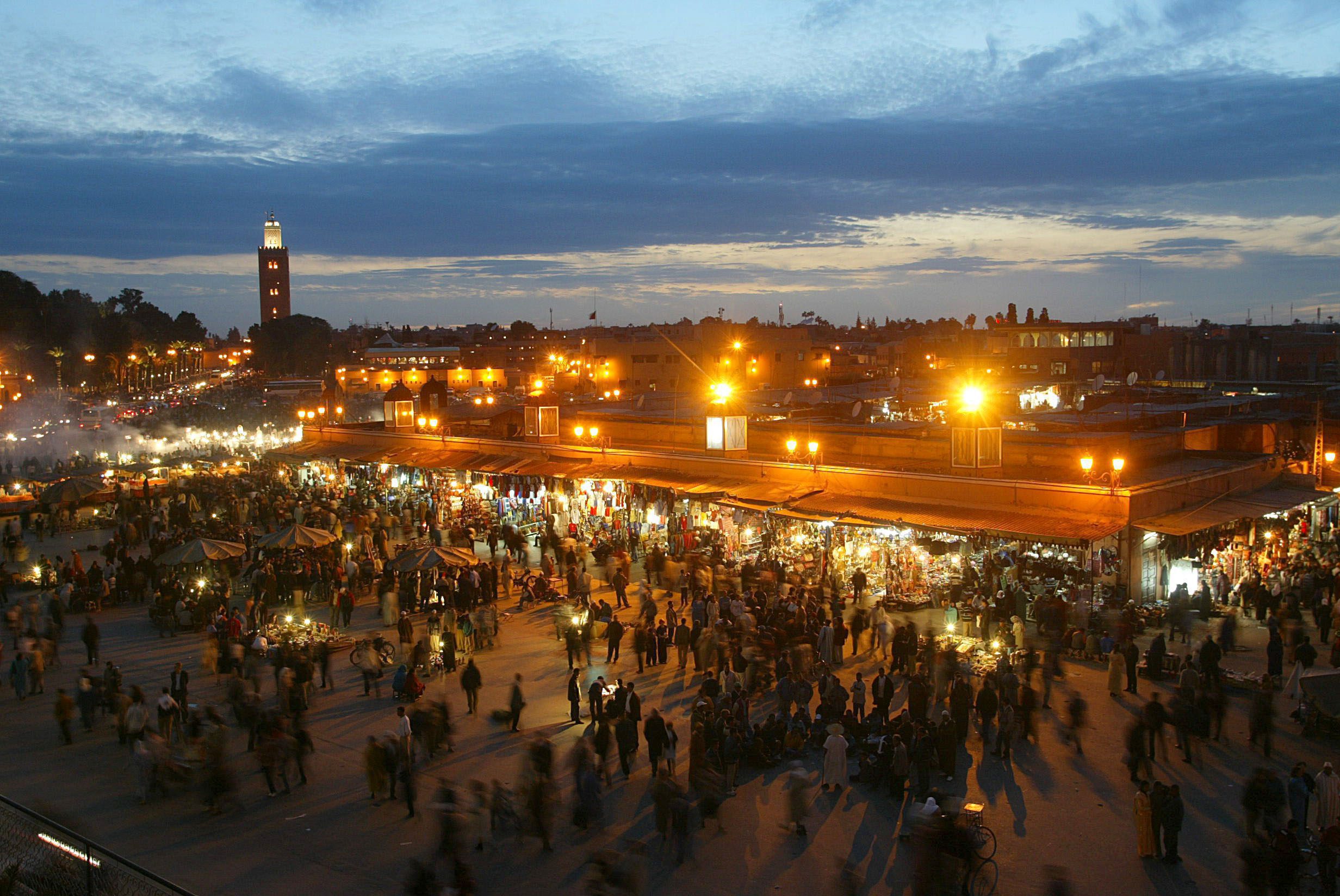
Is Morocco the right destination for you?
Because Morocco is so diverse, it has a little something for everyone. The jet-set regularly hit the town in Marrakesh, while history, archaeology, and architecture buffs keep busy in cities like Fez and Meknès. Active travelers enjoy sandboarding or camelback safaris in the desert and hiking/camping in the Atlas Mountains. The more adventurous traveler will more fully appreciate all the area’s offerings. With a range of accommodation, from simple to extraordinary luxury, anyone with a taste for adventure and an eye for beauty, who appreciate experiencing new cultures, tastes, sights and sounds is sure to enjoy Morocco.
When to visit Morocco?
April through early June and September through November are much more comfortable in terms of temperatures, and there are fewer fellow tourists. June through August can be extremely hot, while the winter months are quite cold, especially in the Sahara and Atlas mountains.
How much should I budget for a trip to Morocco?
Morocco: luxury & private safaris.
Costs for food, accommodation, and travel in Morocco are fairly low by European or North American standards. If you eat local, use more basic hotels, and share expenses with another person, the price is reasonable. You could travel well on $300-$500 per person per night; however, with $700 – $1,000 per person per night, you would enjoy luxury and a truly exceptional, high-service experience.
Our favorite areas
Morocco is such an incredibly diverse country that we simply couldn’t pick just one or two areas. Marrakech is a bustling city with an ancient old town, which is endlessly interesting. Travelers, especially the French, head here to enjoy the sun, good food, and lovely people in an exotic, but comfortable and accommodating environment. Fez, on the other hand, feels much more authentic and is home to many fine artisans, making it a “must visit” city. The narrow alleys in the medina’s make you feel like you are in a time warp that has transported you to the Middle Ages! The Moroccan Sahara and the Atlas Mountains offer unprecedented beauty and encounters with the natural world. A stop in the Ouarzazate / Skoura region offers access to incredible architecture and the opportunity to visit a real oasis. Combining these areas creates the perfect journey, a complete and unforgettable picture of this incredibly exotic country.
What else should I know before traveling to Morocco?
- Morocco: Luxury & Private Safaris: People who want clean, orderly destinations that resemble home wouldn’t like Morocco. The sights, smells, and sounds of the Moroccan souks are infamously overwhelming (not to mention getting lost in the city’s winding passages); although a guide can be a lifesaver, particularly if you are unsure of your comfort level. Additionally, single female travelers may not want to explore Morocco alone, and cities, in particular, can be challenging for solo travelers. However, you can get around this by using our excellent local drivers and guides or doing some touring with groups that we can arrange for you.
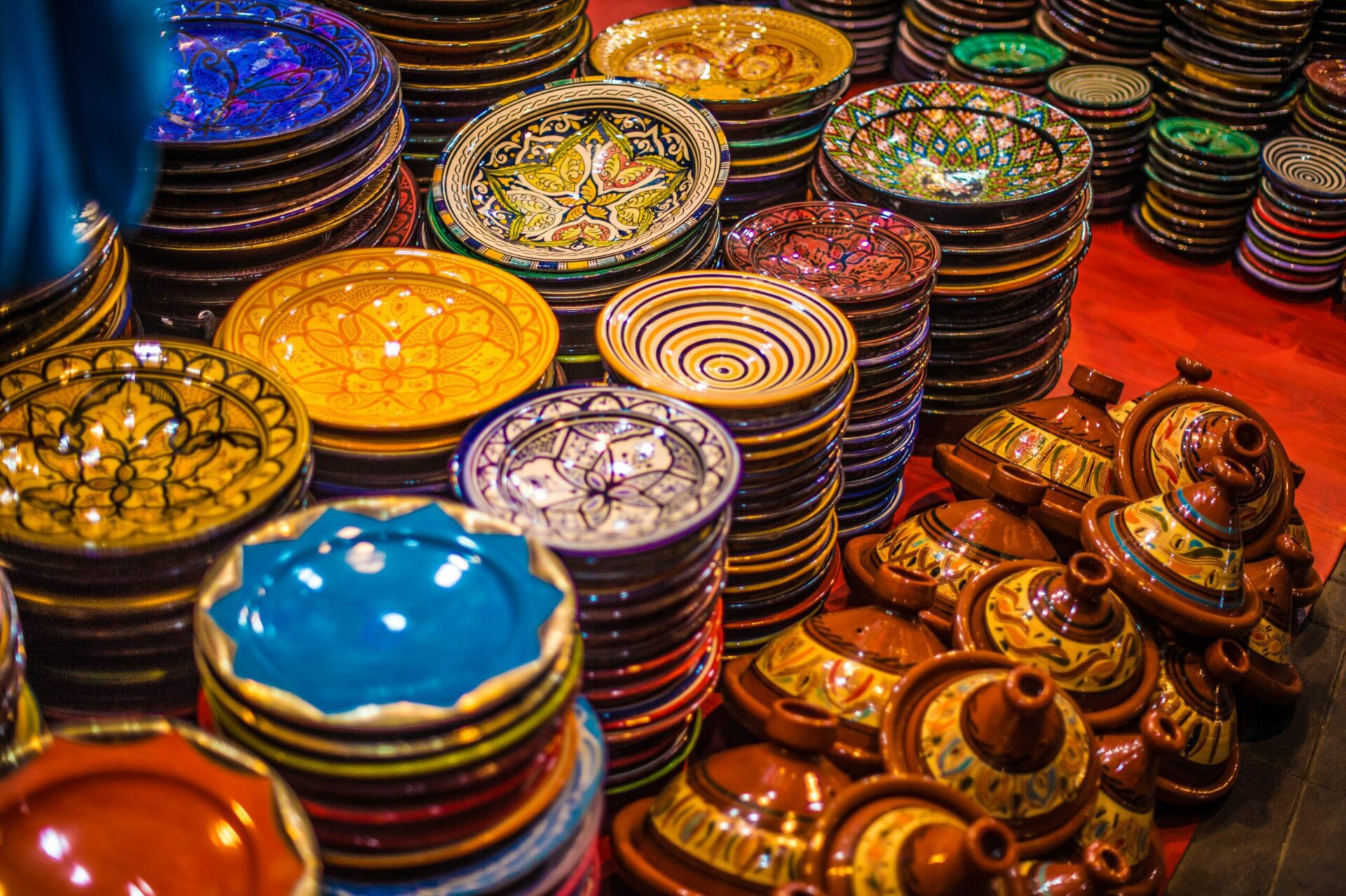
Negotiate for vibrant goods
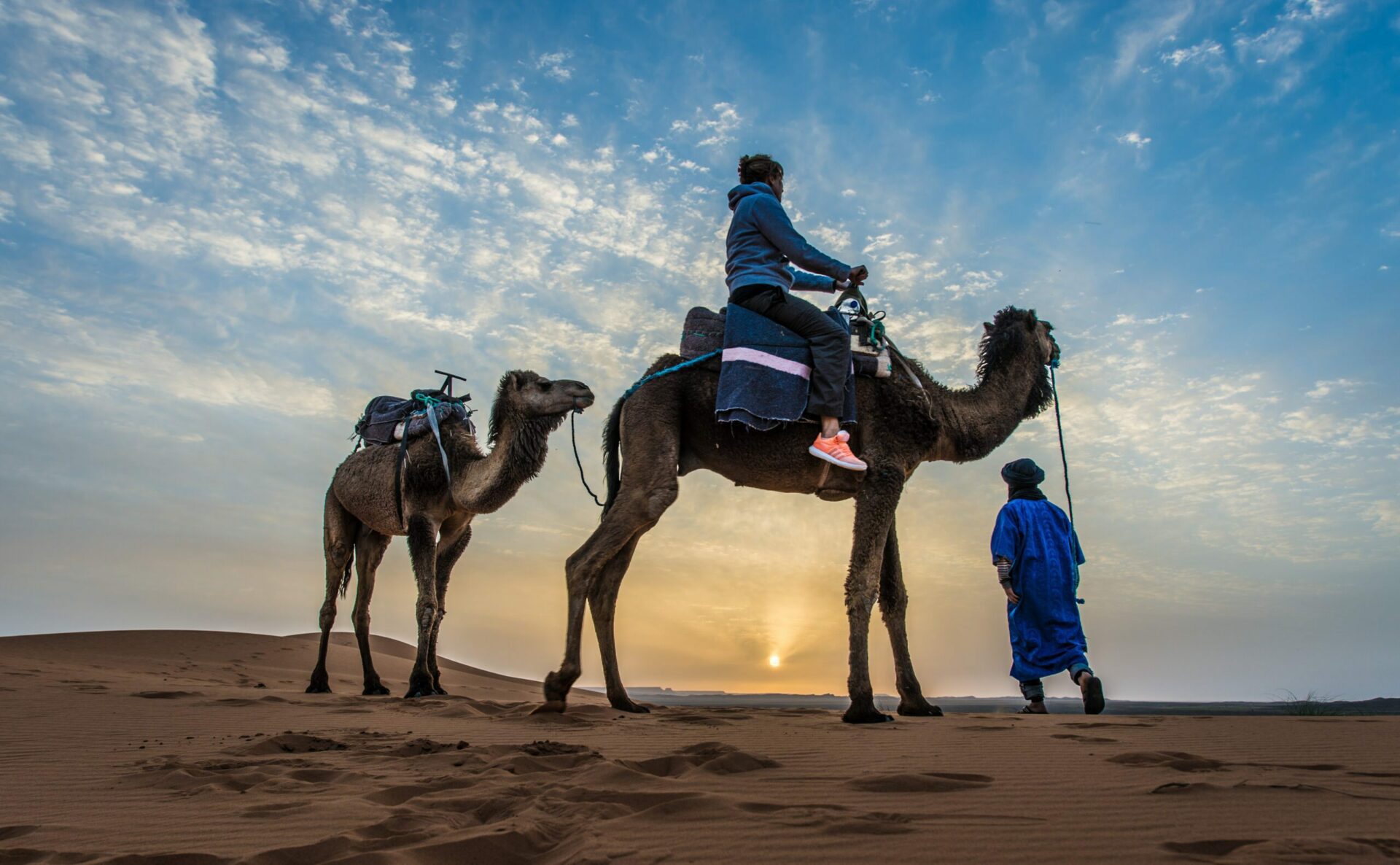
Ride into the sunset by camel
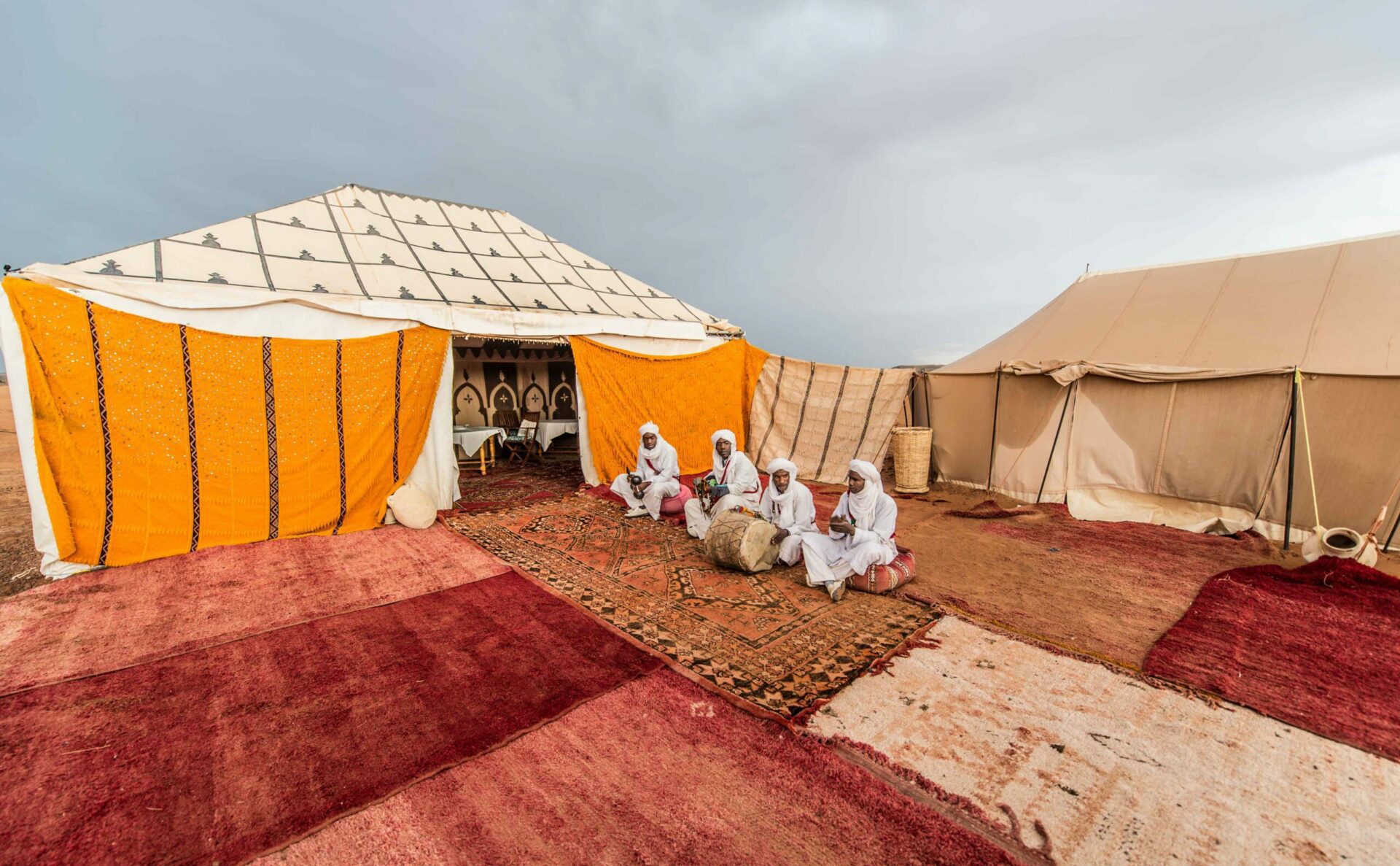
Camp in the desert

Relax in a Moroccan hammam
Ways to experience Morocco
Experiencing Morocco is really all about appreciating the culture and traditions of this truly magical place. Don’t be afraid to be a tourist, particularly in Fez, where history smacks you in the face at every turn. Eat and drink your way through the medina in Marrakech, ask your guide lots of questions, and make a few memorable purchases – leather slippers perhaps, then have an amazing dinner at Le Jardin. You can day trip to a couple of the lesser-known imperial cities, such as Meknès, and travel to the iconic Sahara Desert (even if it’s just for a night!). We also recommend spending one or two nights in the Atlas Mountains hiking and experiencing the raw beauty of the landscape and the local Berber culture. A guided tour of the ancient agricultural workings of an oasis near Skoura is fascinating while exploring a compact town like Essaouira and the beach on your own is a nice way to end your journey.
Let us help you plan a bespoke trip of a lifetime for you.
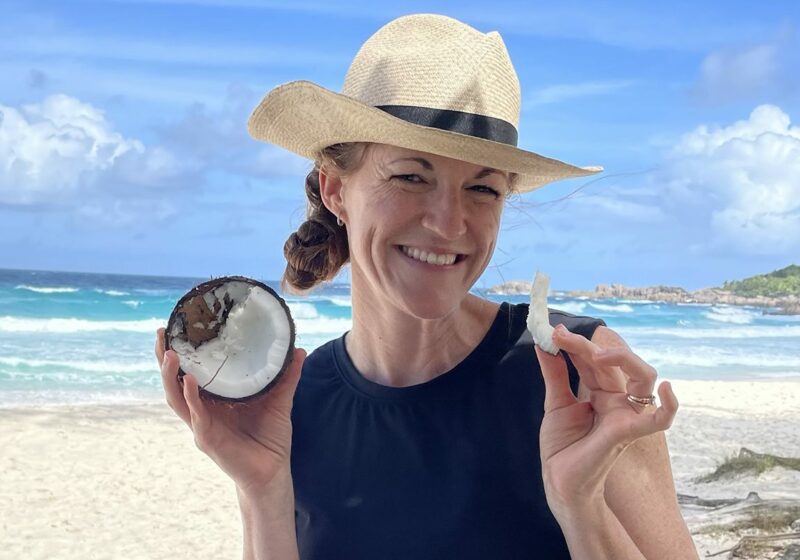
Moments Log
Blogging every moment of your life

International Food Safari: A Gastronomic Adventure
Table of contents, exploring the culinary delights of asia: a journey through flavors, unveiling the richness of european cuisine: from parisian pastries to mediterranean delicacies.
Embarking on a South American Food Expedition: Discovering the Vibrant Tastes of Latin America
Indulging in African Gastronomy: From Moroccan Tagines to South African Braais
Embark on a global culinary journey with International Food Safari : A Gastronomic Adventure .
Asia is a continent known for its rich and diverse culinary traditions. From the spicy flavors of Thailand to the delicate tastes of Japan, there is something to satisfy every palate. Embarking on an international food safari through Asia is a gastronomic adventure like no other. Join us as we take you on a journey through the flavors of this vibrant continent.
Our first stop on this culinary exploration is Thailand. Known for its bold and spicy cuisine, Thai food is a feast for the senses. From the tangy and aromatic flavors of Tom Yum soup to the fiery heat of Green Curry, Thai cuisine is a perfect balance of sweet, sour, salty, and spicy. Don't forget to try the famous Pad Thai, a stir-fried noodle dish that is a staple of Thai street food. The combination of fresh ingredients and complex flavors will leave you craving more.
Next, we travel to China, a country with a culinary history that spans thousands of years. Chinese cuisine is incredibly diverse, with each region having its own unique flavors and cooking techniques. From the fiery Sichuan cuisine to the delicate flavors of Cantonese dishes, there is something for everyone. Be sure to try the iconic Peking Duck, a dish that has been perfected over centuries. The crispy skin and succulent meat are a true delight for the taste buds.
Continuing our journey, we arrive in Japan, a country renowned for its precision and attention to detail. Japanese cuisine is all about simplicity and letting the natural flavors of the ingredients shine. Sushi, sashimi, and tempura are just a few of the dishes that have gained international fame. The art of sushi-making is a true testament to the skill and craftsmanship of Japanese chefs. Each piece is carefully crafted to create a harmonious balance of flavors and textures.
Moving on, we find ourselves in India, a country known for its vibrant spices and bold flavors. Indian cuisine is a true reflection of the country's diverse culture and history. From the creamy and aromatic curries of the north to the spicy and tangy dishes of the south, there is a world of flavors to explore. Don't miss out on trying the iconic butter chicken or the fragrant biryani. The combination of spices and herbs will transport you to the bustling streets of India.
Our final destination on this culinary adventure is Vietnam. Vietnamese cuisine is all about freshness and balance. The use of herbs, vegetables, and light sauces creates dishes that are both healthy and delicious. Pho, a traditional Vietnamese noodle soup, is a must-try. The combination of tender beef or chicken, aromatic herbs, and flavorful broth is a true delight. Don't forget to try the famous banh mi, a Vietnamese sandwich filled with a variety of meats, pickled vegetables, and fresh herbs.
As our international food safari comes to an end, we reflect on the incredible flavors and experiences we have encountered along the way. From the bold and spicy dishes of Thailand to the delicate and precise flavors of Japan, Asia truly is a gastronomic paradise. Whether you are a seasoned foodie or just starting your culinary journey, exploring the flavors of Asia is an adventure that will leave you craving more. So pack your bags and get ready for a gastronomic journey like no other. Bon appétit!

Let's start our culinary adventure in the city of love, Paris. Known for its exquisite pastries and desserts, Paris is a haven for those with a sweet tooth. From the famous macarons at Ladurée to the delicate éclairs at L'Éclair de Génie, there is no shortage of delectable treats to satisfy your cravings. As you stroll through the charming streets of Paris, make sure to stop by a local bakery and indulge in a freshly baked croissant or pain au chocolat. The buttery, flaky layers will melt in your mouth, leaving you craving for more.
Leaving Paris behind, we now venture into the Mediterranean region, where a whole new world of flavors awaits us. From the sun-drenched shores of Greece to the vibrant streets of Italy, the Mediterranean is a treasure trove of culinary delights. In Greece, be sure to try the traditional moussaka, a layered dish of eggplant, minced meat, and béchamel sauce. The combination of flavors and textures is simply divine. And let's not forget about the iconic Greek salad, with its fresh tomatoes, cucumbers, olives, and feta cheese. It's a refreshing and healthy option that will leave you feeling satisfied.
As we make our way to Italy, we find ourselves in the land of pasta and pizza. Italian cuisine is renowned worldwide for its simplicity and use of fresh ingredients. Whether you're indulging in a classic Margherita pizza in Naples or savoring a plate of homemade pasta in Rome, you can't go wrong with Italian food. The secret lies in the quality of the ingredients and the passion that goes into preparing each dish. Don't forget to try the gelato, a creamy and flavorful Italian ice cream that will transport you to dessert heaven.
Continuing our journey, we arrive in Spain, where tapas reign supreme. Tapas are small, flavorful dishes that are perfect for sharing with friends and family. From patatas bravas, crispy potatoes topped with a spicy tomato sauce, to gambas al ajillo, succulent garlic shrimp, there is something for everyone to enjoy. Pair your tapas with a glass of sangria or a refreshing glass of gazpacho, a chilled tomato soup that is perfect for hot summer days.
Our final stop on this European culinary adventure takes us to the charming streets of Vienna, Austria. Known for its coffee culture, Vienna is the perfect place to indulge in a cup of rich, aromatic coffee and a slice of Sachertorte, a decadent chocolate cake. The Viennese also take pride in their schnitzels, thin and crispy breaded meat that is a true delight. Don't forget to try the traditional apple strudel, a sweet pastry filled with apples, cinnamon, and raisins. It's the perfect ending to a delicious meal.
As our international food safari comes to an end, we hope that you have enjoyed this gastronomic journey through the richness of European cuisine. From Parisian pastries to Mediterranean delicacies, each country has its own unique flavors and culinary traditions to offer. So pack your bags and get ready for a culinary adventure like no other. Bon appétit!
South America is a continent known for its rich cultural heritage, breathtaking landscapes, and vibrant cuisine. From the spicy flavors of Mexico to the hearty dishes of Argentina, South American cuisine offers a gastronomic adventure like no other. Embarking on a food expedition through this diverse region is a surefire way to tantalize your taste buds and immerse yourself in the local culture.
One of the first stops on your South American food safari should be Mexico. Mexican cuisine is a fusion of indigenous ingredients and Spanish influences, resulting in a unique and flavorful culinary experience. From the fiery heat of chili peppers to the earthy richness of corn, every bite tells a story. Don't miss out on trying traditional dishes like tacos, enchiladas, and guacamole. And of course, no Mexican meal is complete without a refreshing margarita or a shot of tequila.
Continuing your journey south, you'll find yourself in the vibrant country of Peru. Peruvian cuisine is a delightful blend of indigenous ingredients, Asian influences, and Spanish flavors. One of the most famous dishes from Peru is ceviche, a refreshing dish made with raw fish marinated in citrus juices and spices. Another must-try is lomo saltado, a stir-fry dish that combines tender beef, onions, tomatoes, and French fries. And for dessert, indulge in a slice of tres leches cake or a creamy lucuma ice cream.
As you venture further into South America, you'll arrive in Argentina, a country renowned for its love of meat. Argentine cuisine is centered around the asado, a traditional barbecue where various cuts of meat are grilled to perfection. Sink your teeth into a juicy steak or savor the flavors of chorizo and morcilla, traditional Argentine sausages. Pair your meal with a glass of Malbec, Argentina's famous red wine, and you'll have a dining experience fit for a gaucho.
Next on your food expedition is Brazil, a country known for its vibrant street food culture. From the bustling streets of Rio de Janeiro to the colorful markets of Salvador, Brazil offers a wide array of delicious treats. Try coxinha, a deep-fried dough filled with shredded chicken, or acarajé, a deep-fried ball of black-eyed pea dough stuffed with shrimp and spices. And don't forget to sample a caipirinha, Brazil's national cocktail made with cachaça, lime, and sugar.
Last but not least, your South American food safari wouldn't be complete without a visit to Colombia. Colombian cuisine is diverse and influenced by its indigenous, Spanish, and African roots. Start your culinary adventure with a hearty bandeja paisa, a platter filled with rice, beans, plantains, avocado, and various meats. For a snack, try arepas, cornmeal patties filled with cheese, meat, or eggs. And to satisfy your sweet tooth, indulge in a slice of tres leches cake or a traditional Colombian dessert called postre de natas.
Embarking on a South American food expedition is a gastronomic adventure that will leave you craving for more. From the spicy flavors of Mexico to the meaty delights of Argentina, the vibrant tastes of Latin America will captivate your senses and introduce you to a world of culinary wonders. So pack your bags, prepare your taste buds, and get ready for a journey that will take you on a delicious exploration of South America's diverse and flavorful cuisine.
Are you a food lover with a taste for adventure? If so, then an international food safari might just be the perfect gastronomic adventure for you. Embark on a journey that will take your taste buds on a whirlwind tour of the world, exploring the diverse and delicious cuisines of different countries and cultures. In this section, we will be indulging in the flavors of Africa, from the aromatic spices of Moroccan tagines to the smoky goodness of South African braais.
When it comes to African cuisine, Morocco is often the first country that comes to mind. Known for its rich and flavorful dishes, Moroccan cuisine is a true delight for the senses. One of the most iconic dishes is the tagine, a slow-cooked stew that is traditionally cooked in a clay pot of the same name. The combination of tender meat, aromatic spices, and sweet dried fruits creates a harmony of flavors that is simply irresistible. Whether it's a lamb tagine with prunes and almonds or a vegetable tagine with chickpeas and preserved lemons, each bite is a taste of Morocco's vibrant culinary heritage.
Moving southwards, we find ourselves in the rainbow nation of South Africa, where the braai (barbecue) is a way of life. South Africans take their braais seriously, and it's not just about grilling meat. It's a social event that brings friends and family together to enjoy good food and good company. From succulent steaks and boerewors (sausages) to grilled seafood and flavorful marinades, the options are endless. The smoky aroma of the grill fills the air as the meat sizzles, creating a mouthwatering feast that is best enjoyed with a cold beer or a glass of South African wine.
But African cuisine is not just limited to Morocco and South Africa. The continent is home to a diverse range of culinary traditions, each with its own unique flavors and ingredients. In West Africa, countries like Nigeria and Ghana are known for their spicy stews and soups, often made with ingredients like okra, yam, and palm oil. In East Africa, countries like Ethiopia and Kenya offer a taste of the exotic with dishes like injera (a sourdough flatbread) and nyama choma (grilled meat). And in Southern Africa, countries like Zimbabwe and Botswana showcase their love for maize-based dishes like sadza (a thick porridge) and samp (crushed maize kernels).
No matter where you go in Africa, you are sure to find a gastronomic adventure waiting to be discovered. From the bustling markets of Marrakech to the vibrant townships of Cape Town, the flavors of Africa will captivate your taste buds and leave you craving for more. So why not embark on an international food safari and indulge in the rich and diverse cuisines of this beautiful continent? Your taste buds will thank you for it.
In conclusion, African cuisine offers a world of flavors and culinary traditions that are waiting to be explored. From the aromatic spices of Moroccan tagines to the smoky goodness of South African braais, each dish tells a story and offers a glimpse into the rich cultural heritage of the continent. So pack your bags, grab your appetite, and get ready for a gastronomic adventure like no other. Bon appétit!
Share this:


IMAGES
VIDEO
COMMENTS
Maeve journeys into the world of Moroccan food and meets a range of top chefs and home-cooks who are passionate about their delicious cuisine.
My Crazy Moroccan Food Safari. eatingtheglobe May 5, 2014 Food Tours. I wander through the medina's chaotic streets, my stomach growling with hunger. Vendors constantly surround me trying to get me to buy rugs, argan oil, and vibrant spices. Old women clutch my clothing asking for money. One man even chases me around the square, trying to ...
Moroccan: Directed by Toufic Charabati. With Maeve O'Meara, Mostofa Ennaim, Malika Ennaim, Sara Ennaim. Moroccan Safari - Maeve journeys into the world of Moroccan food and meets a range of top chefs and home-cooks who are passionate about their delicious cuisine.
S1.E7 ∙ Chinese. Wed, Jan 17, 2007. Food Safari plunges into the intricate, balanced, thoughtful world of Chinese food where flavor and using fresh seasonal produce reign supreme. Maeve O'Meara joins one of the senior statesmen of Chinese food - chef and teacher Robert Ho to learn what basic ingredients are needed for a Chinese pantry.
From the hearty comfort of bissara, a fava bean soup, to the irresistible charm of msemen, a flaky pancake that's both crispy and soft, the vibrant street food scene is a window into the heart and soul of Moroccan culinary culture. 5. Fresh And Zesty Salads. Moroccan meals often kick off with a burst of freshness in the form of vibrant salads.
Finally, add the sugar, mint leaves, and first glass to the bottom of the teapot over the gunpowder leaves. Fill the teapot to the top with hot water, cover and steep for a 5-10 minutes. If your teapot doesn't have a built in strainer for the gunpowder tea, strain it before pouring into a glass.
Food Safari journeys into the beguiling, gently spiced world of Moroccan food and meets a range of top chefs and home cooks who are passionate about t…
Moroccan - Food Safari (Season 1, Episode 1) - Apple TV (CA) ... Apple TV+
Food Safari journeys into the beguiling, gently spiced world of Moroccan food and meets a range of top chefs and home cooks who are passionate about their delicious cuisine. Food author and broadcaster Maeve O'Meara joins her friend restaurateur Omar Majdi who gives tips on the top spices and ingredients needed for Moroccan food.
Arrange the chicken pieces in the centre of the tajine. Coat the potato wedges in a little more marinade and arrange around the chicken. Top with the sliced onion, then the sliced tomato, and push ...
In each episode of Food Safari, Maeve O'Meara visits a different cuisine, taking you into kitchens and restaurants across the nation to learn new recipes.
contact/. My Moroccan Food. Moroccan food blog. Moroccan cooking made simple and easy. Modern Moroccan, recipes, cuisine and dishes. Traditional Moroccan recipes and Moroccan inspired recipes. Tagine, couscous, bastila, appetizers, pastries, deserts recipes and more. Facts about ingredients, spices and Moroccan cuisine culture.
Put lamb in a bowl, add rest of ingredients and, using hands, combine to cover all of lamb. Refrigerate for at least 1 hour. Grill to medium rare on the bbq. Don't forget the minted yogurt. This recipe featured on Australia's "Food Safari" on a Moroccan show they did. They are simple to prepare and taste delicious and very refr.
Thinking of going to Morocco?Well, the cuisine is one of many reasons why you definitely should!Whilst we spent a few days in Essaouira (on the West coast) w...
Food Safari's chicken tagine | SBS Food. Like. Comment. Share. 81 · 3 comments · 4.5K views. SBS Food posted a video to playlist Bitesize.
Beef, lamb, and chicken are the most common meats and a typical meal will always include some kind of meat as well as salad, couscous, bread, and vegetables. Tagine is the typical way of cooking dishes, and in general, you'll find Moroccan food to be very healthy. The main influences of the Moroccan cuisine can be traced back to Berber ...
Heston's Moroccan vegan couscous with spiced romesco. Mini chicken pastillas. One-pot rose harissa chicken and apricot pilaf. ... What to cook, the latest food news, exclusive giveaways - straight ...
Review of: Marrakech: Atlas, Berber Villages, Agafay & Camel Ride. Written April 21, 2024. This review is the subjective opinion of a Tripadvisor member and not of Tripadvisor LLC. Tripadvisor performs checks on reviews. Elise K.
Morocco: Luxury & Private Safaris. Costs for food, accommodation, and travel in Morocco are fairly low by European or North American standards. If you eat local, use more basic hotels, and share expenses with another person, the price is reasonable. You could travel well on $300-$500 per person per night; however, with $700 - $1,000 per ...
As our international food safari comes to an end, we hope that you have enjoyed this gastronomic journey through the richness of European cuisine. ... From the aromatic spices of Moroccan tagines to the smoky goodness of South African braais, each dish tells a story and offers a glimpse into the rich cultural heritage of the continent. So pack ...
Food author and broadcaster Maeve O'Meara joins her friend restaurateur Omar Majdi who gives tips on the top spices and ingredients needed for Moroccan food. S1 E2 - Episode 2. December 13, 2006. 25min. ALL. Food Safari journeys into the intense spicy world of Malaysian food whose devotees cross oceans for the best laksa, roti and curry.